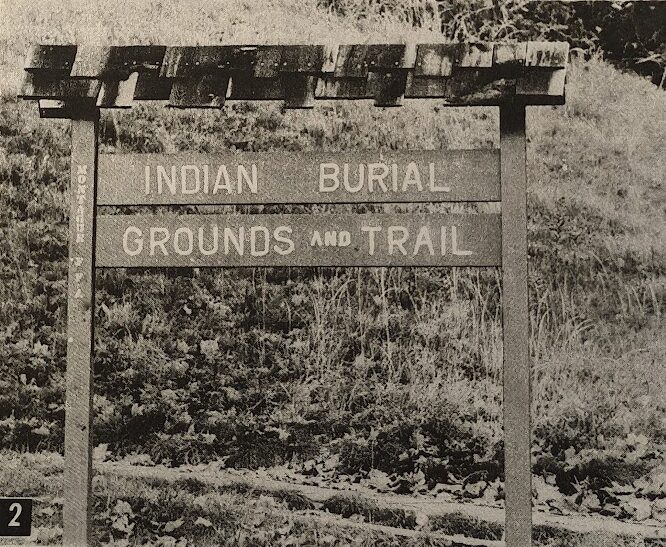
The Ottawa Indians, one of the many Native American tribes in West Michigan, have a rich history that dates back thousands of years. They originally inhabited the areas around the Great Lakes, including what is now Michigan. The Ottawa were known for their skills in fishing, hunting, and trading. They played a significant role in the fur trade with European settlers and established trade routes that stretched across the region. Their villages were typically located along rivers and lakes, providing easy access to water and transportation.
Ottawa Indian Activity in White Lake
In 1787, in one such quiet Ottawa village on the Grand River, a small dark-eyed baby girl was born. This girl, who was later named Quis-Mo-Qua, would eventually be laid to rest in a sacred Indian burial ground, a place that lies less than 100 feet from downtown Montague.
Quis-Mo-Qua’s life story is intertwined with the rich history of the Ottawa people. In the early 1800s, she married an Ottawa Indian who adopted the Christian name Anderson. Their legacy continued through their daughter, She-Ka-Gaw, who married a man named Armstrong. The descendants of their two sons, Thomas and George, still reside in the White Lake area today.
Quis-Mo-Qua lived a full and rich life, passing away on December 12, 1897. She was buried at the top of a high bluff overlooking the upper end of the Old Channel, a place that had long been a sacred burial ground for the Ottawa people.
This burial ground is closely tied to the old Indian trail that paralleled the lake. The trail ran from Indian Point Village to the Trading Post at the convergence of Carleton Creek and the White River, passing near the burial grounds where many others also lay in peaceful rest.
Re-Discovering a Sacred Indian Burial Ground
As the town of Montague grew and the advent of the automobile brought new developments, the need for roads increased. During the grading and preparation for paving Old Channel Trail, engineers uncovered the ancient burial grounds. Work was immediately halted due to the sacred nature of the site.

Thomas Armstrong, who lived just north of the area, voiced his concern over the disturbance of the burial grounds. His mother, She-Ke-Gaw, intervened and offered a solution, saying, “No son, let them finish, doing as little harm as possible and place the concrete over their graves. Then they will rest in peace.”

Thus, the sacred Indian burial ground came to be preserved just yards north of what is now downtown Montague. This site remains a testament to the rich history and cultural heritage of the Ottawa people and their enduring presence in the region.
This article is based on research by W. Lipka, who has chronicled the story of Quis-Mo-Qua and the sacred burial grounds, ensuring that this important piece of history is not forgotten.
As we deliver articles weekly, I challenge you to be curious, explore the local area, and take pictures at these historic locations, and tag CatchMark Community.
Next week we will explore Ben Mac Dhui and the controversial clergyman John Alexander Dowie. If you enjoy history and like our content please like and subscribe to our online resources. Also, check out the White Lake Area Historical Society website listed below.
http://www.whitelakeareahistoricalsociety.com/
https://www.facebook.com/CatchMarkCommunity
Brent is the Managing Partner of CatchMark Technologies and a seasoned technologist with over 25 years of experience in IT leadership, cybersecurity, and technical operations. He began his career serving in the U.S. Army, where he worked extensively with electronics—laying the foundation for his lifelong passion for technology and problem-solving. Brent holds a Certified Information Systems Security Professional (CISSP) certification and currently leads CatchMark’s Cybersecurity and Tech Support teams. Known for his strategic thinking and hands-on expertise, he excels in guiding secure, scalable solutions and driving innovation across complex technical environments.
Must See
-


Community
/ 2 hours agoWhitehall Township Board Meeting Recap – June 23, 2025
The Whitehall Township Board held its regular monthly meeting on Monday, June 23, 2025,...
By Kara Raeth -


Arts/Entertainment
/ 8 hours agoWhite Lake Live Music: June 23–29 Lineup
It’s a big week for local music fans! 🎶 Eight Whitehall and Montague venues...
By Amy Yonkman -


Community
/ 2 days agoHunters and Anglers: Urban Deer Hunting in Whitehall and Montague
WHITEHALL & MONTAGUE, MI — As deer populations continue to rise across West Michigan,...
By Kara Raeth












